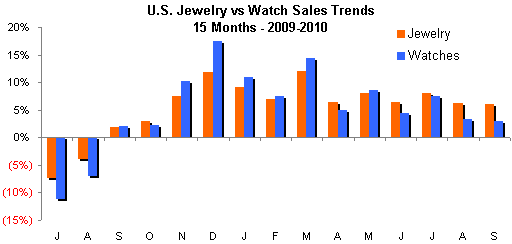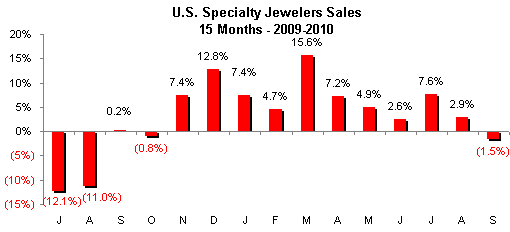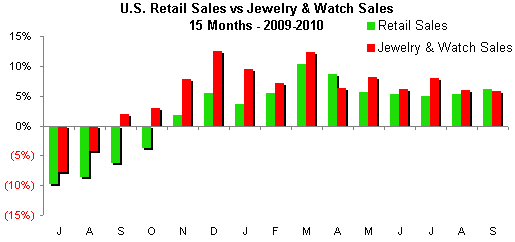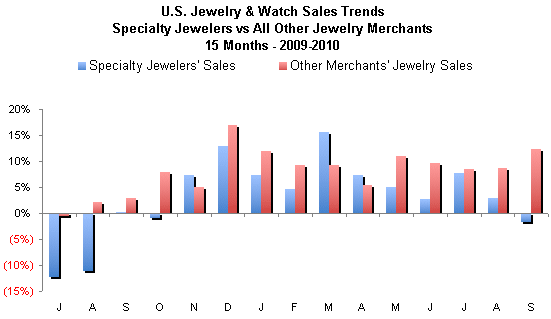IDEX Online Research: Consumer Demand for Jewelry Slowed in September
November 22, 10
(IDEX Online) - September jewelry sales in the U.S. were up 5.7 percent in September versus the same period last year, but the momentum softened from prior months. However, we are not too worried.
We are not too worried for the following reasons:
· The IDEX Online Research sample of specialty jewelers showed that sales results were mixed in September. While the U.S. Department of Commerce reported a modest decline in sales, we think the numbers may be revised upward over the next month or so. We know that preliminary numbers often are revised, sometimes sharply.
· September appears to be an aberration. Very early indicators suggest that October jewelry demand strengthened, and November is off to a solid start for most jewelers.
· We continue to forecast that U.S. jewelry sales will likely set a record in 2010.
Here’s the scoreboard for September U.S. retail and jewelry sales:
Retail Category September 2010 Vs September 2009 Total Retail Sales – All Categories +7.7% Total Retail Sales – Ex-Auto & Food +6.1% Total Jewelry & Watch Sales +5.7% Total Jewelry Sales +6.0% Total Watch Sales +3.0% Total Specialty Jewelers’ Sales (1.5%) Total “Other” Merchants’ Jewelry Sales* +12.4%
Source: U.S. Department of Commerce
*Jewelry sales at all merchants not classified as “specialty jewelers.” Includes Wal-Mart,
J.C. Penney, Kohl’s, Costco and others
September Jewelry Sales Highlights
Highlights of September jewelry sales in the U.S. market include the following:
Total Jewelry Sales Running Ahead, But Momentum Slowing
· Total U.S. jewelry and watch sales rose by 5.7 percent in September, to an estimated $4.0 billion versus $3.8 billion last year. This was the smallest percentage sales gain for any of the first nine months of this year.
These figures include all jewelry and watches sold by any merchant – specialty jewelers, multi-line retailers, online sellers and any other retail channel. September’s jewelry and watch sales of $4.0 billion were about in line with March and April sales levels of about $4.0 billion each – both months with no major jewelry sales events – but below $5.2 billion in May, $4.3 billion in June, $4.1 billion in July, and $4.4 billion in August. The incremental sales in May – roughly $1.2 billion – reflect demand for Mother’s Day jewelry.
The table below compares U.S. monthly jewelry sales in billions of U.S. dollars for the first seven months of 2010 versus the same period in 2009. Due to rounding, the numbers may not foot and cross exactly.
|
· Watch sales were stronger than jewelry sales earlier this year, but this is largely due to easy comparisons against 2009 watch sales, which were dismal. In both August and September, watch demand softened, and watch sales were weaker than jewelry sales. In September, total watch sales were up 3.0 percent, while total jewelry sales were ahead by 6.0 percent, for a blended gain of 5.7 percent.
Sales figures from the LGI Network for September indicated that watch sales were down about 5 percent, though same-store watch sales ran ahead by about 11 percent. Unit sales of watches were down about 4.6 percent in September, according to the LGI Network survey. The LGI Network sales tally tracks fine watch sales, while the Department of Commerce tracks all watch sales.
 Source: U.S. Department of Commerce |
Specialty Jewelers Post Weak September Sales
Specialty jewelers’ sales represent just under half of all jewelry sales in the U.S. on an annual basis. In September, their sales were about $1.9 billion, about 47 percent of total industry sales of $4.0 billion.
· Specialty jewelers posted a disappointing 1.5 percent decline in sales in September 2010 versus the same month a year ago. This was well below the year-to-date sales gain of 5.5 percent for U.S. specialty jewelers. We believe that it is highly likely that the Department of Commerce will revise the preliminary September sales figure upward in subsequent months.
The graph below summarizes specialty jewelers’ monthly sales gains for the past 15 months. There is significant variation in the monthly sales gains since the recovery began in September 2009, as the graph illustrates. Typically, there is significant monthly volatility in jewelry sales during an economic recovery.
 Source: U.S. Department of Commerce |
· Specialty jewelers’ preliminary sales fell to $1.927 billion in September 2010, slightly below September 2009’s $1.956 billion. September’s sales were slightly below sales levels during months without specific sales events such as Valentine’s and Mother’s Day.
· Looking ahead, September 2009 was the first month of the recovery cycle, and sales comparisons become more difficult for the next several months. Thus, we expect more modest sales gains for specialty jewelers in the final three months of this year. However, we caution that sales could be choppy until the U.S. economy shows solid signs of a sustained recovery.
Jewelry Compared to Other Retail Sectors
In most economic cycles, jewelry sales dip further than total retail sales, and rise faster during the recovery period. This was the trend earlier in 2010. Unfortunately, specialty jewelers have not participated in this recovery as much as other retailers who sell jewelry. Historically, specialty jewelers lose market share in a recession, and never regain it; this has occurred in the recession of 2008 and 2009.
· Jewelry sales have shown greater gains than total retail sales every month this year, with the exception of April and September. Overall, this indicates that jewelry is gaining market share – share of wallet – during the recovery period. As noted, this trend often occurs early in the economic growth cycle. The graph below illustrates jewelry sales trends (red bars) versus total retail sales trends (green bars).
 Source: U.S. Department of Commerce |
· Specialty jewelers continued to lose market share in September. In 2009, specialty jewelers ended the year with a 48.0 percent market share of all jewelry sold, down 80 basis points from the prior year’s 48.8 percent (all data has been revised to reflect new annual and monthly figures released in July 2010 by the government). In January and February of 2010, specialty jewelers lost market share, but in March and April, the trend reversed. However, for the past five months, specialty jewelers’ sales gains were notably below the jewelry industry average, indicating that they have lost market share overall.
 Source: U.S. Department of Commerce |
Outlook: Still Bright for Jewelry
The U.S. jewelry industry remains poised to post record sales this year. Based on current trends through the first nine months of 2010, IDEX Online Research is forecasting that jewelry sales in the U.S. market could reach $62.2 billion this year, up sharply from last year’s $58.8 billion, and about modestly ahead of 2007’s record level of $62.0 billion. The U.S. Department of Commerce figures indicate that jewelry sales could surpass $63.0 billion this year.
IDEX Online Research is forecasting a record holiday selling period – November-December 2010 – both at the retail level and at the supplier level. Retail jewelry sales could reach $20.0 to $20.1 billion this year, about in line with – or slightly ahead of – the prior record holiday period in 2007, just before the recession of 2008-2009 began.
While the U.S. economic recovery remains somewhat anemic, two key factors are expected to improved jewelry sales throughout the distribution pipeline:
· Consumer Demand – The three segments that were largely responsible for dragging the economy into the recession – job losses, stock market declines and housing market woes – appear to have stabilized and may be in a recovery mode. While the stock market remains volatile, it has shown an amazing recovery since its bottom in the first quarter of 2009. Further, real estate values have begun to recover in some markets. Finally, joblessness has not gotten worse, and appears to be improving in selected metros.
· Pipeline Restocking – Suppliers throughout the distribution chain report that orders have picked up, mostly due to re-stocking at all levels of the pipeline. Retailers have finally begun to realize that they cannot make sales without inventory in their stores. As they have placed orders, others in the distribution chain have begun to add to their inventories.
IDEX Online Research knows this much about American consumers: they are tired of the recession, and they are ready to start spending again; and there is an old American adage that just might be the salve for Christmas 2010 – “when the going gets tough, the tough go shopping.”